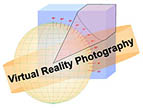

![]() Ask the VR Photography Experts
Ask the VR Photography Experts
![]()
Q: I know its possible to make a lot of your own VR photography hardware, such as pan heads and turntables, but usually this eqquipment winds up looking “home made.” If I want to shoot VR professionally, isn’t it important to show up in front of clients with professional looking tools such as a professional camera and a commercial VR head from companies like Manfrotto or Kaidan?
![]()
A: While I think there is some element of truth to your concerns, I think it is important not to put too much emphasis on equipment and how you think you look using it.
Certainly showing up to a major shoot with only a point and shoot camera and a $5.99 Lazy Susan will not exactly inspire confidence nor seem to justify your $3,500 per day fee, even though you may be so skilled with these tools that the client will be awed by your results. While appearances are often important, they are only a facade covering the real engine of your creativity, skill and abilities.
I know professional photographers who can blow the doors off of most others' creative abilities using nothing more than an old Kodak Brownie or a pinhole camera made from a shoe box. I know others who show up for shoots with tens of thousands of dollars of camera and lighting equipment, yet who struggle to make a usable image.
The important thing is that you be competent and able to create the images that your clients want/need on demand. For me, that simply means having equipment I can rely on.
Companies like Kaidan, Manfrotto, Peace River Studios and Corybant West make a number of fine VR photography hardware products. If one's budget allows, simply place an order, unpack the box several days later, and be off shooting (and looking impressive to your fellow photographers, who might be drooling over your new hardware <g>). But remember when you're shooting professionally, that your job is NOT to impress other photographers, but to impress your clients, who usually are far more concerned with your results than with your choices of equipment.
I have more than a dozen VR pan heads that I've accumulated over the years, some of which are commercial products and others which I designed or built myself. I have been known to bring several of them, along with a many cases of other gear, to big shoots. Mostly this is done to ensure that I have backups or am prepared for every possibility that might arise (you'd be amazed at the number of surprises that can come your way on big shoots). But invariably, I find that the pan head I use 95 percent of the time is a home made version made from three pieces of aluminum, which I paid a local machinist about $160 to cut and shape for me close to 8 years ago. This was a time when there were few, if any, commercial heads available, and I needed something more efficient and effective than the kludge of off-the-shelf hardware that Apple recommended in their original Authoring Tools Suite manuals.
It's not terribly pretty -- the aluminum is not anodized and has seen a lot of wear, some of the steel bolts holding it together are showing rust, there are no detent mechanisms, no motors, no springs nor counterweights. But it's strong, reasonably lightweight and allows me to do just about everything I need to shoot panoramas effectively. A camera attaches to it via an Allen wrench and a hex bolt. This bolt is necessarily held in place by a (very high tech) piece of gaffer's tape when no camera is attached. I once even had a stranger come up to me while I was shooting and say "that's not exactly a quick release system, is it?" But not once has a single client ever cared about how my VR pan head looked, and I have used this rig on the biggest shoots of my career.
Years ago, a well known commercial photographer made the following observation about photographers and the evolution of their equipment:
Years 1-5: Build everything (because you can't afford to buy it)
Years 6-10: Buy everything
Years 11-15: Build everything (because you now have to modify most
of what you buy and you're more particular about what
it should do)
![]()
Bottom line is to choose the equipment that is most suited for the job at hand, and which you can afford. This might range from a home made bracket that you hammered from coat hanger wire or the cheapest thing you could find at your local rental house, to the latest and greatest commercial model or a custom-machined mechanism that cost you many thousands of dollars to make.
My personal philosophy is that I do everything I can to avoid being limited by my equipment. As a professional, you can't tell clients that you weren't able to deliver what they needed because you didn't have the right tools. I want to know that any limitation encountered is a personal limitation (which I can do something about), not an equipment shortcoming (which I have far less control over in the field). That way I always know where the blame for mistakes lies -- squarely on my shoulders -- and that is exactly where I can correct them.
On the other hand, however... remember that we usually do our best work when we are challenged to a degree. Success is best savored when we've had to overcome at least a little adversity along the way.
Even the best road trips aren't complete until you've gotten lost or run out of gas at least once... (grin).
- Scott Highton